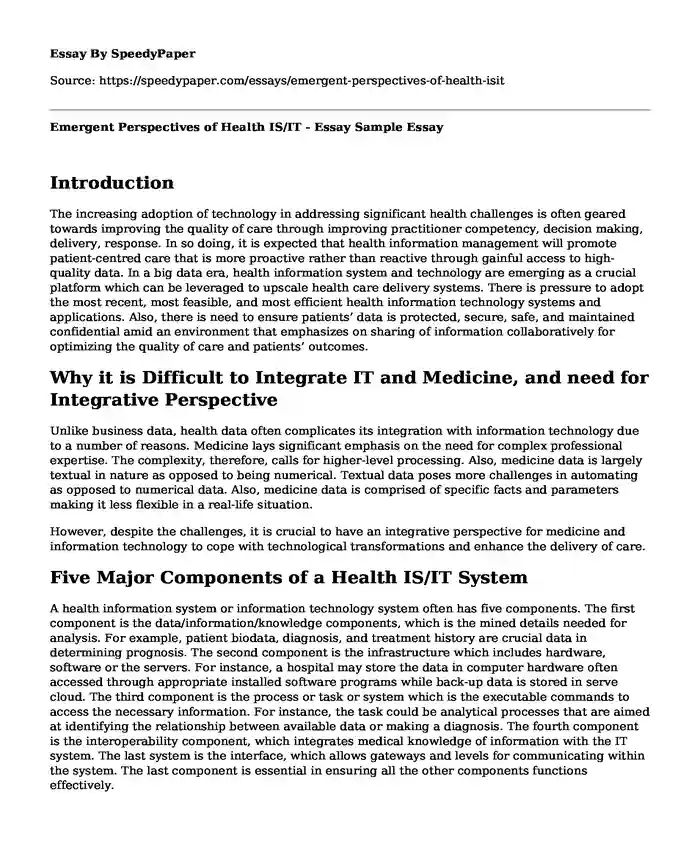
| Type of paper: | Essay |
| Categories: | Medicine Technology Healthcare |
| Pages: | 3 |
| Wordcount: | 683 words |
Introduction
The increasing adoption of technology in addressing significant health challenges is often geared towards improving the quality of care through improving practitioner competency, decision making, delivery, response. In so doing, it is expected that health information management will promote patient-centred care that is more proactive rather than reactive through gainful access to high-quality data. In a big data era, health information system and technology are emerging as a crucial platform which can be leveraged to upscale health care delivery systems. There is pressure to adopt the most recent, most feasible, and most efficient health information technology systems and applications. Also, there is need to ensure patients’ data is protected, secure, safe, and maintained confidential amid an environment that emphasizes on sharing of information collaboratively for optimizing the quality of care and patients’ outcomes.
Why it is Difficult to Integrate IT and Medicine, and need for Integrative Perspective
Unlike business data, health data often complicates its integration with information technology due to a number of reasons. Medicine lays significant emphasis on the need for complex professional expertise. The complexity, therefore, calls for higher-level processing. Also, medicine data is largely textual in nature as opposed to being numerical. Textual data poses more challenges in automating as opposed to numerical data. Also, medicine data is comprised of specific facts and parameters making it less flexible in a real-life situation.
However, despite the challenges, it is crucial to have an integrative perspective for medicine and information technology to cope with technological transformations and enhance the delivery of care.
Five Major Components of a Health IS/IT System
A health information system or information technology system often has five components. The first component is the data/information/knowledge components, which is the mined details needed for analysis. For example, patient biodata, diagnosis, and treatment history are crucial data in determining prognosis. The second component is the infrastructure which includes hardware, software or the servers. For instance, a hospital may store the data in computer hardware often accessed through appropriate installed software programs while back-up data is stored in serve cloud. The third component is the process or task or system which is the executable commands to access the necessary information. For instance, the task could be analytical processes that are aimed at identifying the relationship between available data or making a diagnosis. The fourth component is the interoperability component, which integrates medical knowledge of information with the IT system. The last system is the interface, which allows gateways and levels for communicating within the system. The last component is essential in ensuring all the other components functions effectively.
The IS/IT Culture of Choice as a Chief Information Officer
As a Chief Information Officer, I would pursue information-inquiring culture. This culture allows the employees to lay emphasis on understanding the organizational core believes, values, and purpose. Also, the culture enhances access to critical information to better understand the current situation and prepare for future trends. With both health and technology being dynamic and flexible, there is need to allow the inquiry culture among employees which enables the institution to keep abreast with changes which should be adopted for improving the delivery of quality care.
Digital Health Ecosystem and its Impacts on the Transformation of Healthcare Services
Digital health ecosystem describes a technology platform that enables access to a variety of consumer-centric services. The ecosystem enhances interconnectivity for different stakeholders such as health care providers, provider systems, patients, payment services, and other critical healthcare stakeholders. The digital ecosystem has profound impacts on transforming healthcare service delivery in the US and other countries. For starters, most countries have or are progressively adopting electronic health records, which will need a platform to synthesize the big data generated for such systems; thus, a significant potential use for digital health ecosystem. The digital health ecosystem will also facilitate the seamless exchange of health information. Besides, it also improves of delivery of health services while encouraging the appropriate channelling on available information.
Reference
Tan, J. (2010). Adaptive health management information systems: Concepts, cases, and practical applications (3rd Ed.). Jones and Bartlett Publishers
Cite this page
Emergent Perspectives of Health IS/IT - Essay Sample. (2023, Dec 16). Retrieved from https://speedypaper.com/essays/emergent-perspectives-of-health-isit
Request Removal
If you are the original author of this essay and no longer wish to have it published on the SpeedyPaper website, please click below to request its removal:
- PTSD Research Paper Example
- Free Essay: Review of Regulations and Standards for Surgical Site Infection
- Fast Food Industries and Health - Argumentative Essay Example
- Skills for Disruptive Digital Business - Free Essay with the Article Review
- Health Promotion in Nursing Practice - Diabetes Essay Example
- Essay Sample: Reflection on the Global Health Crisis: COVID-19 Pandemic Impact and Response
- Empowering Lives: A Comprehensive Journey in Diabetes Self-Management - Free Report
Popular categories




